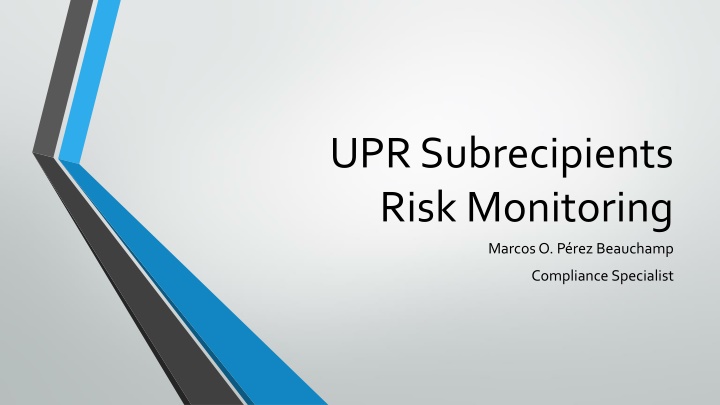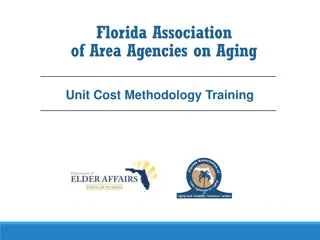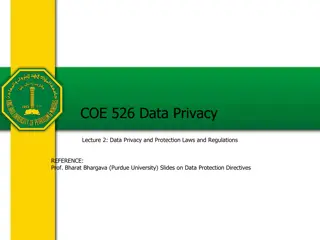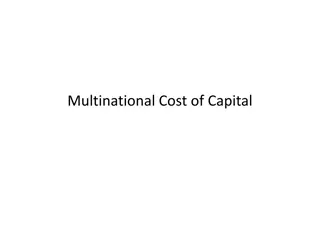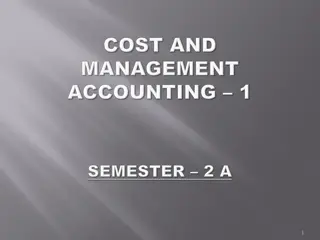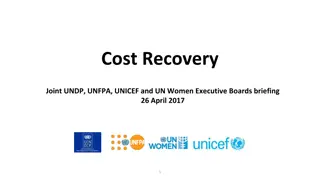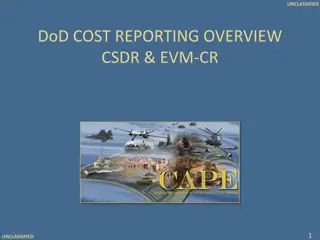Basic Concepts of Cost Principles and Regulations
This content covers the basic concepts of cost principles and regulations in grant agreements, focusing on the standards for the allowability of costs, detailed guidance on cost accounting treatment, and applicability based on the type of organization. It explains the differentiation of contract requirements between UPR units and external entities, defines accounting practices, and establishes official UPR documents for grant agreements.
Download Presentation

Please find below an Image/Link to download the presentation.
The content on the website is provided AS IS for your information and personal use only. It may not be sold, licensed, or shared on other websites without obtaining consent from the author.If you encounter any issues during the download, it is possible that the publisher has removed the file from their server.
You are allowed to download the files provided on this website for personal or commercial use, subject to the condition that they are used lawfully. All files are the property of their respective owners.
The content on the website is provided AS IS for your information and personal use only. It may not be sold, licensed, or shared on other websites without obtaining consent from the author.
E N D
Presentation Transcript
UPR Subrecipients RiskMonitoring Marcos O. P rez Beauchamp ComplianceSpecialist
Session norms Put your phone into silent, mute or vibrate mode Questions related to a topic could be made during the presentation Question on a specific case will be answer at the end of the presentation Training Materials will be available via google drive
Agenda Basic Concepts Subrecipient Monitoring Background Subrecipient Monitoring Guide
Basic Concepts Finance Office circular 16-17 Approved in september 28, 2015, amended on june 30, 2016. Differentiates the contract requirements of grants agreements between UPR units from grants agreements with external entities. Defines the accounting for grant agreements between UPR units. Establishes the Intercampus Subaward Agreement as the official UPR document to be used to formalized grants agreements between UPR units.
Basic Concepts 2 CFR 200 (Uniform Guidance) Subparte A Acronyms and definitions (2 CFR 200.0 200.99) Subparte B General Provisions (2 CFR 200.100 200.113) Subparte C Pre-award Requirements and Contents of Federal Awards (2 CFR 200.200 200.212) Subparte D Post Federal Award Requirements (2 CFR 200.300 200.345) Subparte E Cost Principles (2 CFR 200.400 200.475) Subparte F Audits Requirements (2 CFR 200.500 200.520) Appendix 5
Basic Concepts Cost Principles (2CFR 200Subpart E) Establishes standards for the allowability ofcosts. Provides detailed guidance on the cost accounting treatment of costs as direct or F&A costs. Sets allowability and allocability principles for selected items of cost. Applicability of a particular set of cost principles depends on the type of organization (regardless whether domestic or foreign) making theexpenditure.
Basic Concepts Cost PrinciplesAplicability: Applicable Cost Principles Regulation Type of Organization College or University State, Local, or Indian Tribal Government Nonprofit Organization Profitmaking Organization 2 CFR 200 48 CFR 31.2 Hospital usually 45 CFR 75, Appendix IX
Basic Concepts Cost Principle Example: A for-profit organization collaborating with a university recipient would be subject to the cost principles for commercial organizations (48 CFR 31.2), while the university would be subject to the cost principles for Institutions of Higher Educations (2 CFR 200).
Basic Concepts 200.86, Recipient - Non-Federal entity that receives a Federal award directly from a Federal awarding agency to carry out an activity under a Federal program. 200.74, Pass-through entity - Non-Federal entity that provides a subaward to a subrecipient to carry out part of a Federal program. 200.93, Subrecipient - Non-Federal entity that receives a subaward from a pass-through entity to carry out part of a Federal program. 200.23, Contractor (replaces term vendor , used in A-133) - means an entity that receives a contract.
Types of Agreements 200.201, Pass-through entity must decide on the appropriate instrument for the FederalAward: 200.51 -Grant agreement 200.24 -Cooperative agreement 200.22 -Contract
Fixed Amount Awards Fixed amount awards (New) (See200.332 and 200.45) Requires prior approval from Federal awarding agency Payments are based on meeting specific requirements of the FederalAward Accountability is based on performance and results Award amount is negotiated using cost principles as a guide (Up toSimplifiedAcquisitionThreshold (currently $150,000)) No governmental reviewofthe actual costs incurred
Subaward vs. Contract SUBRECIPIENT 200.330(a) CONTRACTOR / VENDOR Determines who is eligible to participate in a federal program Provides the goods and services within normal business operations Has its performance measured against whether the objectives of the federal program are met Provides similar goods and services to many different purchasers Is responsible for programmatic decision making Operates in a competitive environment Provides goods or services that are ancillary to the operation of the federal program Is responsible for complying with federal program requirements Is not subject to the compliance requirements of the federal program as a result of the agreement Uses the federal funds to carry out a program
Subrecipient Risk Monitoring Background 2 CFR Part 200 establishes the uniform administrative requirements, cost principles and audit requirements for federal awards. The requirements responsibilities of federal awarding agencies and pass- through entities in awarding, monitoring, and closing out of grant awards. also include
Subrecipient Risk Monitoring Background Regarding risk monitoring of subawards, the 2 CFR 200, section 200.331 (6)(b) indicates the following need: Evaluate each subrecipient s risk of noncompliance with Federal statutes, regulations, and the terms and conditions of the subaward for purposes of determining the appropriate subrecipient paragraph (e) of this section, considerationofsuch factorsas... monitoring described may in which include
Subrecipient Risk Monitoring Background 200.331(6)(e), Depending upon the pass-through entity s assessment of risk posed by the subrecipient (as described in paragraph (b) of this section), the following monitoring tools may be useful for the pass-through entity to ensure proper accountability and compliance with program requirementsandachievementofperformancegoals... . Providing subrecipients with training and technical assistance Performing on-site reviews
Subrecipient Risk Monitoring Background 200.331(h), Pass-through entities must consider taking enforcementaction based on noncompliance, including: Temporarily withholding cash payments pending correction Disallowing all or part of the cost Wholly or partly suspending the award Recommending suspension/debarment to federal awarding agency Withholding furtherfederal awards Other remedies that may belegally available
Subrecipient Risk Monitoring Background 200.339, The pass-through may terminate the award for cause with notice and opportunity for hearing (200.340 and 200.341)
Who must comply? These are to be fulfilled for financial management systems, procurement, reports and records, and grant closeouts for non-federal entities. The requirements also include responsibilities of federal awarding agencies and pass-through entities in awarding, monitoring, and closing out of grant awards.
SubrecipientMonitoring Guide Designed for subawards that are subject to federal and/or agency-specific regulations established by the federal prime sponsor. Monitoring procedures should be determined by the PI and administrators based on the nature of the grant and the perceived risk associated with the subrecipient.
SubrecipientMonitoring Guide Collection of documents to assist administrators at the responsible offices and central level with subrecipient monitoring. Additional monitoring efforts implemented if there is any question about the subrecipient s ability to ensure proper use and financial management of sponsor funds during any stage of the award. should always be
SubrecipientMonitoring Guide Based on: Various US Intensive Research Universities procedures Federal Demonstration Patnership UPR Peer reviews Review of related policies used on UPR units
SubrecipientMonitoring Guide Award Stages Initial Award Stage Monitoring Ongoing Monitoring SubawardCloseout
Initial Award Stage Includesproposal throughawardset-up. The goal of subrecipient monitoring efforts at this stage is to ensure that the subrecipient is capable of compliantly spending the federal funds and meeting the project goals. A risk assessment should be performed to assess the potential risk level of a subrecipient.
Initial Award Stage A questionnaire relating to the organization s financial and management strength can be completed internally or by the subrecipient. The results of the risk assessment should be used to determine the frequency and scope of subrecipient monitoring. The monitoring plan should include strategies to mitigate potentialrisks ofnon-compliance
SubrecipientProfile Questionnaire The questionnaire is used to help determine a subrecipient organization s financial and management strength, which helps assess risk and dictates the monitoring plan for subrecipients. The questionnaire can be completed by the subrecipient or by the UPR responsible office before an agreement is madewiththesubrecipient. Questions may be omitted or added to obtain information most usefulfor developingamonitoringplan.
SubrecipientProfile Questionnaire (Cont.) Address and contact information Company Information Type of organization Fiscal year Organization classification Name of designated federal cognizant agency, if applicable Negotiated Federal Facilities and Administrative rate Internal policies Contact information Required to comply with the 2 cfr 200, Subpart F-Audit Requirements (Single Audit) Does the organization have a financial management system that provides records that can identify the source and application of funds for award-supported activities? Does the financial system provide for the control and accountability of project funds, property, and other assets?
Subrecipient Risk Assessment Evaluation Form Used by responsible offices to assess the level of risk posed by the subrecipient. The form focuses on federal and federal flow-through funds and should not beusedfor externalfunds otherthan that. The form is organizedinto four separatesections: ThresholdQuestions OtherConsiderations InstitutionalQuestions ProjectSpecificQuestions
Subrecipient Risk Assessment Evaluation Form (Cont.) ThresholdQuestions Intended to quickly identify the highest risk candidates: debarred or suspended, lack of COI policy, and the existence or not of an established accounting system, and acceptable procurement system. If the subrecipient is identified as debarred or suspended, on the SAM system, and the UPR still need to make an agreement with this specific subrecipient, then it is required to obtain prior approval from the prime sponsor.
Subrecipient Risk Assessment Evaluation Form (Cont.) OtherConsiderations Intended to assess risk that may or may not result in additional languagein thesubaward. Institutional (Subrecipient)Questions (Scored) These questions focus on institutional characteristics of the subrecipientand areindependentlyscored. For institutions that receive $750,000 or more in federal funds, this institutional score should be static during the year, but may change aftertheirsingleaudit has beencompleted. For institutions under the $750,000 threshold, this number may changeduring theyear.
Subrecipient Risk Assessment Evaluation Form (Cont.) ProjectQuestions (Scored) Focusonthe characteristics of the project and are independently scored. Scoring Methodology A subaward with another UPR campus or unit should be considered as low risk. Subaward may be considered as lower risk if it receives an institutional score of at most 9, a project score of at most 13, or a combination total of institutional and project score below 26. An institutional score over 9, a project score over 13, or total combined score equal or above 26 constitute a higher risk subaward.
Risk Levels / Lower Risk Review audit reports If findings exist determine materiality and risk(s) Review invoices frequentlyto ensure:Timeliness, completeness and accuracy Science is in line with spendingPI approval states okay to pay Work is performed within the period of performance Compliance with special terms (if applicable)
Risk Levels / Higher Risk Review all steps in the Lower Risk category in addition to the following: Exercise your right to audit or consider performing a site visit or desk review Request supporting detailfor all financial invoices and expenses Request and review financial reports more frequently Request regular contact and communication with the PI Document conversations and retain pertinent emails Withhold payments if necessary Elevate potential risksto the Office of Compliance Research and Integrity for review and discussion
Ongoing Monitoring Includes activities undertaken to monitor the subrecipient s administration, billing and scientific progress as well as on- going riskassessments (i.e.review ofannual audit findings). Frequent communication between the PI, responsible offices staff and research administrators at UPR and the subrecipient institution is essential to ensure a compliant and successful collaboration. Charges appear reasonable and progress to date for the project.
Ongoing Monitoring To ensure proper use of sponsor funds, the invoices must be monitoredforcompleteness. Best practice dictates documenting all efforts related to subrecipientmonitoring.
Guide for review of subaward invoices Not invoicing for amounts over the approved budget Invoicing based on actual expenses only Invoice total correct? Facilities & Administration (F&A) costs calculated correctly Invoice signed by an authorized institutional official? Allowability Expenses included in the subaward budget? Are the expenses in the agreement consistent with the programmatic plan PI approval signature Expenses incurred timely
Subrecipient Monitoring Record UPR info Subrecipient info Sub-Award Period of Performance Project Invoicing Frequency Name and position of the person of the UPR responsible for overseeing this record Scheduled Reporting Dates (based on the terms of the grant award) Informal Progress Reports Completed Other Communications
SubawardCloseout Includes activities related to ensuring that the work was performedandproperlybilled The responsible office had the responsibility to ensure that all documentation related to project performance and financialobligationsarereceived Verifying final invoice and reviewing all technical/financial reports to ensure that the subrecipient provided all project deliverablesandmetproject obligations
Subrecipient Monitoring Contact Information Office of ResearchCompliance and Integrity Phones: 787-281-0994 Direct 787-250-0000 ext. 3141, 3126, 3151, 3125 Emails: carlos.rodriguez107@upr.edu marcos.perez1@upr.edu Central Finance Office Phone: 787-250-0000 ext. 4001, 4311 Email: gloria.soto@upr.edu
